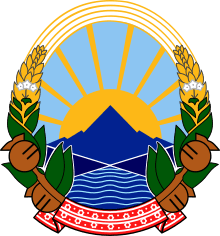Kruševo
Kruševo (Macedonian: Крушево, [ˈkruʃevo] (![]()
Kruševo | |
|---|---|
| Macedonian: Крушево Aromanian: Crushuva | |
 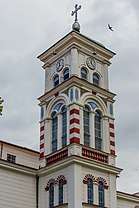 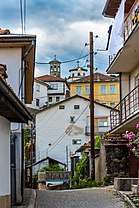  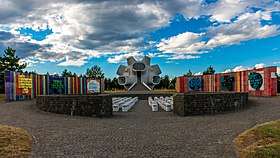 A northern view, St. Nicholas Church, a common street, a south-eastern view, paragliding championship, Makedonium Monument. | |
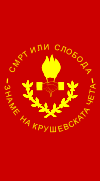 Flag  Coat of arms | |
 Kruševo Location within North Macedonia | |
| Coordinates: 41°22′12″N 21°14′54″E | |
| Country | |
| Region | |
| Municipality | |
| Government | |
| • Mayor | Tome Hristoski (SDSM) |
| Elevation | 1,350 m (4,430 ft) |
| Population () | |
| • Total | 5,330 |
| Time zone | UTC+1 (CET) |
| • Summer (DST) | UTC+2 (CEST) |
| Postal code | 7550 |
| Area code(s) | +389/48/47X-XXX |
| Car plates | KS, BT |
| Climate | Cfb |
Name
The name of the town in other Balkan languages is:
History

Medieval
Initially part of the Byzantine Empire, the area was conquered by the First Bulgarian Empire in the 9th century to be conquered again by the Byzantium in the 11th century. The region came shortly under the rule of the short-lived Principality of Prilep of Prince Marko (r. 1371 - 1395), a successor state of the Serbian Empire (1346–1371) where the father of Župan Vukašin Mrnjavčević (co-ruler of King Stefan Uroš V) held the region. The principality and region came under Ottoman Turkish rule in 1395.[3]
Ottoman rule
A large part of the Macedonian population in Kruševo originate from Lazaropole and descend from Mijaks, a Macedonian sub-group who settled in the town alongside the Aromanians by the middle of the nineteenth century.[4][5] Aromanians settled in Kruševo in addition to Orthodox Albanian refugees often in groups of families and led by a priest fleeing the 18th century socio-political and economic crises in what is now southern Albania.[4][5] Orthodox Albanians arrived from Vithkuq and the Opar region while local Kruševo traditions also relate that other families arrived from Korçë and the villages of Polenë, Dardhë, and Mborje.[4]
In the 19th century, Kruševo grew as a commercial center with connections throughout the Balkans and beyond. Local merchants such as the Nitsiotas brothers and five other companies were active in Vienna.[6] In the 1860s a Bulgarian municipality and Bulgarian school were established the city.[7] Subsequently, a Bulgarian girls school was opened[8] and it operated simultaneously with the Greek schools in the town. A Romanian school started functioning in Kruševo in 1876.[9] In the early 20th century, Kruševo was a small town in Manastir Vilayet with a mixed population of 4,950 Bulgarians, 4,000 Vlachs (Aromanians) and 400 Christian Albanians, according to Bulgarian geographer Vasil Kanchov's statistics.[10] Due to intermarriage with locals, at the onset of the twentieth century few in the small local Orthodox Albanian community spoke Albanian.[4] A neighbourhood inhabited by Aromanians in Kruševo still bears the name Arbineš meaning Albanians in the Aromanian language.[11] During the Ilinden Uprising in 1903 the rebels proclaimed a short lived Kruševo Republic. Because the uprising was suppressed, the city was almost completely destroyed by the Ottoman army. One of the most important points in the Ilinden uprising was the declaration of the "Manifesto of Kruševo". It called for all the people of Macedonia regardless of their nationality and religion to fight together against the Ottoman Empire. In the area there is a monument called Mečkin Kamen (Bear's Stone). This was the place where Pitu Guli's band (cheta) was trying to defend the town of Kruševo from the Turkish troops coming from Bitola. The band and their leader (voivode) are remembered as heroic defenders of Kruševo and the surrounding villages.

Kingdom of Yugoslavia
From 1929 to 1941, Kruševo was part of the Vardar Banovina of the Kingdom of Yugoslavia.

Demographics
| Part of a series on |
| Aromanians |
|---|
| By region or country |
| Major settlements |
| Language |
| Religion |
| History |
| Related groups |
As of the 2002 census, the town of Kruševo has 5,330 inhabitants and the ethnic composition was the following:[12]
- Macedonians, 4,273 (80.2%)
- Aromanians, 1,020 (19.1%)
- others, 37 (0.1%)
The most common mother tongues in the town include the following:
- Macedonian, 4,562 (85.6%)
- Aromanian, 744 (14.0%)
- others, 24 (0.5%)
The religious composition of the town was the following:
- Orthodox Christians, 5,275 (99.0%)
- others, 55 (1.0%)
- Churches in Kruševo
- Church of St. Nicholas
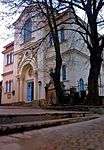 Church of St. Nicholas (2)
Church of St. Nicholas (2)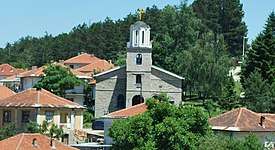 Church of Holy Trinity
Church of Holy Trinity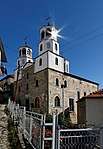 Church of St. John the Baptist
Church of St. John the Baptist- Church of St. Mother of God
Features
Kruševo is a mountainous town. Situated at an altitude of 1,350 metres (4,430 ft), Kruševo is the highest town in North Macedonia. Kruševo is known for its 19th-century domestic architecture. The town has old and more recent houses built in the style of old Macedonian architecture.

It is home to Mečkin Kamen, a historical landmark which marks the spot of the uprising of 1903. On 2 August every year, it is one of the two sites of the traditional Macedonian Day of the Republic celebrations, which are attended by leading Macedonian political leaders.

Kruševo is also home to Makedonium monument, dedicated to the Ilinden Uprising and the Kruševo Republic and many museums of the Ilinden Uprising.
The town's galleries include an exhibit of 19th century icons and a memorial to Macedonian painter Nikola Martinovski who was born in this town.
Because of its elevation, Kruševo is one of North Macedonia's winter sports destinations. Local football club FK Pitu Guli was named after a local revolutionary leader and plays in the Macedonian Second League (East Division).
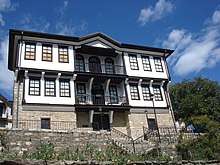
"Ethno-Town Project"
There is a project called "Kruševo ethno-town", supported by the Ministry of Culture of North Macedonia, which was developed by a small group of enthusiasts. According to that project, Kruševo shall look like a town from the beginning of the 20th century where it was the center of the Ilinden Uprising in 1903, that lead to the creation of the first Republic on the Balkans, The Kruševo Republic. People will be dressed like Ottoman Turks and Macedonian revolutionary freedom fighters. The project aims to make Kruševo a main tourist destination in five years.[13]
Notable people
- Toše Proeski, famous singer throughout the Balkans
- Nikola Karev, politician, revolutionary leader
- Pitu Guli, revolutionary leader
- Ioannis Pantazidis (1827-1900), professor of literature in National and Kapodistrian University of Athens
- Vasil Iljoski, writer
- Nikola Martinoski, painter
- Ilija Najdoski, footballer, European Cup champion
- Taki Fiti, politician, minister of finance, author
- Nicolae Batzaria, writer, Ottoman Minister of Public Works and Commerce
- Alexandros Svolos, prominent Greek legal expert, president of the Political Committee of National Liberation, a Resistance-based government during the Axis Occupation of Greece.
- Mencha Karnicheva, revolutionary
- Nikola Gabrovski, military figure
Architecture of Kruševo
 Postcard from Krusevo from 1920s
Postcard from Krusevo from 1920s.jpg) Town architecture
Town architecture Kruševo during winter
Kruševo during winter- A typical house
- Birth house of Nikola Martinoski
 A house where Nikola Karev lived
A house where Nikola Karev lived A typical house
A typical house A typical house
A typical house.jpg) A typical house
A typical house- A typical house
- A typical house
 Tose Proeski Memorial
Tose Proeski Memorial
References
- Kahl, Thede (1999). Ethnizität und räumliche Verbreitung der Aromunen in Südosteuropa. Universität Münster: Institut für Geographie der Westfälischen Wilhelms. p. 147. ISBN 3-9803935-7-7.CS1 maint: ref=harv (link) "Crușuva"
- Information about Krusevo on travel2macedonia.com.mk
- J.VA Fine, The late mediaeval Balkans, p.380
- Koukoudis, Asterios (2003). The Vlachs: Metropolis and Diaspora. Thessaloniki: Zitros Publications. ISBN 9789607760869.CS1 maint: ref=harv (link) p.355. "In many cases, the refugees arrived in organised groups of families with a leader, usually a priest. Right from the start, the Vlachs were accompanied by Arvanites from Vithkuq and the Opar area. Those from Vithkuq preceded those from Opar and occupied the western part of the settlement, forming their own district there. According to local lore, other Arvanite families came from Korçë and the surrounding villages of Polenë, Dardhë, and Mborje. By the early twentieth century, intermarriage meant that very few families spoke Albanian any more."; p. 436. "Mijaks... Quite a large group, from Lazaropole mainly, formed the nucleus of the Slavonic- speaking population of Kruševo, who had settled alongside the Vlachs by the mid-nineteenth century."
- Zografski, Dančo (1986). Odbrani dela vo šest knigi: Makedonskoto nacionalno dviženje. Naša kniga. p. 21.CS1 maint: ref=harv (link) "Населението на Крушево во време на востанието гб сочинуваат Македонци, Власи и Албанци. Први се доселиле во него Власите кон втората половина од XVIII век, односно по познатите грчки востанија од 1769 година..."
- Vacalopulos, Konstandinos A. Modern history of Macedonia, Thessaloniki 1988, p. 138-139
- Иванов, Йордан. Българите в Македония, София 1917, с. 333 (Ivanon, Yordan. Bulgarians in Macedonia, Sofia 1917, p. 333), Ванчев, Йордан. Новобългарската просвета в Македония през Възраждането, София 1982, с. 115 (Vanchev, Yordan. New Bulgarian education in Macedonia during the National Revival, Sofia 1982, p. 115)
- Божинов, Воин. Българската просвета в Македония и Одринска Тракия 1878–1913, София 1982, с. 73 (Bozhinov, Voin. Bulgarian Education in Macedonia and Adrianopole Thrace 1878–1913, Sofia 1982, p. 73)
- Романски, Стоян. Македонските ромъни, Македонски преглед, г. I, 1925, кн. 5-6, с. 83-84 (Romanski, Stoyan. Macedonian Romanians, Macedonian review, 1925, vol. 5-6, p. 83-84) According to other sources the Rumanian school was established in 1868 by A. Margarit - Ласку, Стојка. Од историјата на ароманскиот печат во Македонија. Списанијата "Братство" и "Светлина", Скопје 2007, с. 122
- Васил Кънчов. „Македония. Етнография и статистика“. София, 1900, стр.240 (Kanchov, Vasil. Macedonia — ethnography and statistics Sofia, 1900, p. 39-53).
- Rexha, Iljaz (2011). "Vendbanimet dhe popullsia albane gjatë mesjetës në hapësirën e Maqedonisë së sotme: Sipas burimeve sllave dhe osmane". Gjurmime albanologjike: Seria e shkencave historike (41–42): 178.CS1 maint: ref=harv (link) "Në vendbanimin Krushevë të Maqedonisë së sotme, ishte regjistruar toponimi si lagje me emrin Arbines, dukshëm e banuar me popullsi arumune, e cila e mban edhe sot e kësaj dite formën arumune Arbines, që rrjedh nga forma e mirëfilltë shqipe Arban."
- Macedonian census, language and religion
- Macedonian newspaper 'Vreme' Archived 2011-07-22 at the Wayback Machine
